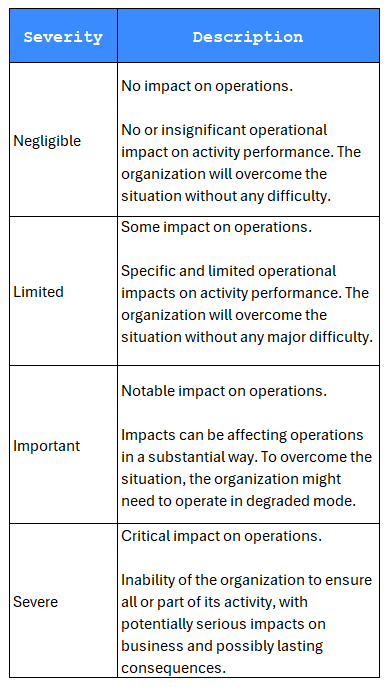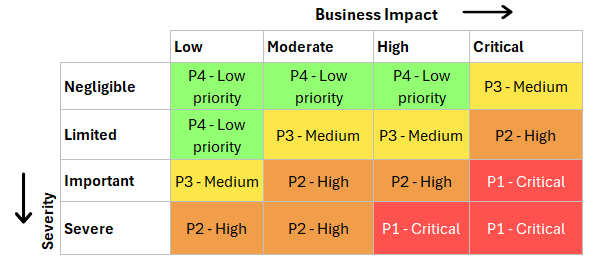Standards
Detection of Data Quality Incidents
This table lists the errors of detected data, their field and the initial impact on the business processes concerned, as well as the status of their resolution. It helps to prioritize remediation efforts according to the severity and impact of errors.

![]() Disclaimer: Please note that the proposed combinations are based on industry best practices. When necessary, they can be customized to meet local specificities and requirements.
Disclaimer: Please note that the proposed combinations are based on industry best practices. When necessary, they can be customized to meet local specificities and requirements.
This summary is built on the basis of the input provided by the Snapshot of Failed Data Report described in the Operational Monitoring Standards.
This list will serve as a reference and a first step to the upcoming phases where a level of impact and severity as well as resolution time will be affected to each incident.
For further details, please refer to the Snapshot of Failed Data Report Page
Assess severity and impact
The severity of the incident is assessed on the basis of its impact on business operations. The following Severity Definition Matrix is proposed to help assess incident severities using formal criteria.

![]() Disclaimer: Please note that the proposed categories are based on market best practices and referential. When necessary, they can be customized to meet local specificities and requirements
Disclaimer: Please note that the proposed categories are based on market best practices and referential. When necessary, they can be customized to meet local specificities and requirements
The incident business impact assessment is done on the Business Impact Assessment Matrix described in the Prioritization standards of the Data Quality Framework.

![]() Disclaimer: Please note that the proposed figures are based on broadly admitted amounts considered as rule of thumb in the market. When necessary, they can be customized to meet local specificities and requirements
Disclaimer: Please note that the proposed figures are based on broadly admitted amounts considered as rule of thumb in the market. When necessary, they can be customized to meet local specificities and requirements
For further details, please refer to the Prioritization standards.
Using the Severity Definition Matrix, the Business Impact Assessment Matrix and the Data Quality Incidents list described in the previous section, the impact and severity levels are identified and assigned to each incident.
The following template is proposed to capture the impact and severity level for each identified incident.

![]() Disclaimer: Please note that the proposed combinations are based on industry best practices. When necessary, they can be customized to meet local specificities and requirements.
Disclaimer: Please note that the proposed combinations are based on industry best practices. When necessary, they can be customized to meet local specificities and requirements.
Prioritize errors for remediation
The prioritization of incidents is based on the evaluation of its severity and its business impact. The following Priority Definition matrix provides a guideline to assign priority based on the combination of the two values.

![]() Disclaimer: Please note that the proposed combinations are based on market best practices and referential. When necessary, they can be customized to meet local specificities and requirements
Disclaimer: Please note that the proposed combinations are based on market best practices and referential. When necessary, they can be customized to meet local specificities and requirements
On the basis of the Priority Definition matrix, a priority level to the identified incidents can be assigned as follows:

![]() Disclaimer: Please note that the proposed combinations are based on industry best practices. When necessary, they can be customized to meet local specificities and requirements.
Disclaimer: Please note that the proposed combinations are based on industry best practices. When necessary, they can be customized to meet local specificities and requirements.
Once the priority level of the incidents are defined, it is necessary to allocate a target incident resolution time. The following matrix is proposed as a guideline to set target resolution times per priority:

![]() Disclaimer: Please note that the proposed figures are based on market best practices and referential. When necessary, they can be customized to meet local specificities and requirements
Disclaimer: Please note that the proposed figures are based on market best practices and referential. When necessary, they can be customized to meet local specificities and requirements
The list of incidents can be updated with target resolution time as follows:

![]() Disclaimer: Please note that some of the columns of the proposed template have been hidden to improve readability. The complete template can be found at the bottom of the page.
Disclaimer: Please note that some of the columns of the proposed template have been hidden to improve readability. The complete template can be found at the bottom of the page.
Remediation Planning and Execution Matrix
Once the incidents have been prioritized, it is essential to define an action plan, assign responsibilities and monitor an action plan progress.
The following table provides guidelines to execute this step:

![]() Disclaimer: Please note that some of the columns of the proposed template have been hidden to improve readability. The complete template can be found at the bottom of the page.
Disclaimer: Please note that some of the columns of the proposed template have been hidden to improve readability. The complete template can be found at the bottom of the page.
Verification
Finally, the verification step helps ensure that the corrective actions have effectively been conducted and finalized.
The following table serves as a guideline to capture final verification status:

![]() Disclaimer: Please note that some of the columns of the proposed template have been hidden to improve readability. The link to the complete template can be found at the bottom of the page.
Disclaimer: Please note that some of the columns of the proposed template have been hidden to improve readability. The link to the complete template can be found at the bottom of the page.
Remediation templates
Please refer to the Data Quality Framework documentation center.